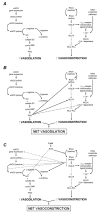Aging and the control of human skin blood flow
- PMID: 20036842
- PMCID: PMC3228253
- DOI: 10.2741/3642
Aging and the control of human skin blood flow
Abstract
Human exposure to cold and heat stimulates cutaneous vasoconstriction and vasodilation via distinct sympathetic reflex and locally mediated pathways. The mechanisms mediating cutaneous vasoconstriction and vasodilation are impaired with primary aging, rendering the aged more vulnerable to hypothermia and cardiovascular complications from heat-related illness, respectively. This paper highlights recent findings discussing how age-related decrements in sympathetic neurotransmission contribute directly to thermoregulatory impairments, whereas changes in local intracellular signaling suggest a more generalized age-associated vascular dysfunction.
Figures








Similar articles
-
Altered mechanisms of thermoregulatory vasoconstriction in aged human skin.Exerc Sport Sci Rev. 2008 Jul;36(3):122-7. doi: 10.1097/JES.0b013e31817bfd47. Exerc Sport Sci Rev. 2008. PMID: 18580292 Free PMC article.
-
Peripheral mechanisms of thermoregulatory control of skin blood flow in aged humans.J Appl Physiol (1985). 2010 Nov;109(5):1538-44. doi: 10.1152/japplphysiol.00338.2010. Epub 2010 Apr 22. J Appl Physiol (1985). 2010. PMID: 20413421 Free PMC article. Review.
-
In vivo mechanisms of cutaneous vasodilation and vasoconstriction in humans during thermoregulatory challenges.J Appl Physiol (1985). 2006 May;100(5):1709-18. doi: 10.1152/japplphysiol.01071.2005. J Appl Physiol (1985). 2006. PMID: 16614368 Review.
-
Sympathetic control of reflex cutaneous vasoconstriction in human aging.J Appl Physiol (1985). 2015 Oct 1;119(7):771-82. doi: 10.1152/japplphysiol.00527.2015. Epub 2015 Aug 13. J Appl Physiol (1985). 2015. PMID: 26272321 Free PMC article. Review.
-
Cutaneous vasodilator and vasoconstrictor mechanisms in temperature regulation.Compr Physiol. 2014 Jan;4(1):33-89. doi: 10.1002/cphy.c130015. Compr Physiol. 2014. PMID: 24692134 Review.
Cited by
-
Exercise training and the control of skin blood flow in older adults.J Nutr Health Aging. 2012 Mar;16(3):237-41. doi: 10.1007/s12603-011-0156-8. J Nutr Health Aging. 2012. PMID: 22456779 Review.
-
Effect of a brief heat exposure on blood pressure and physical performance of older women living in the community-a pilot-study.Int J Environ Res Public Health. 2014 Dec 5;11(12):12623-31. doi: 10.3390/ijerph111212623. Int J Environ Res Public Health. 2014. PMID: 25489997 Free PMC article.
-
POTENTIAL EFFECTS OF WHOLE-BODY VIBRATION EXERCISES ON BLOOD FLOW KINETICS OF DIFFERENT POPULATIONS: A SYSTEMATIC REVIEW WITH A SUITABLE APPROACH.Afr J Tradit Complement Altern Med. 2017 Jul 7;14(4 Suppl):41-51. doi: 10.21010/ajtcam.v14i4S.6. eCollection 2017. Afr J Tradit Complement Altern Med. 2017. PMID: 28740943 Free PMC article.
-
Aging and Thermoregulatory Control: The Clinical Implications of Exercising under Heat Stress in Older Individuals.Biomed Res Int. 2018 Aug 2;2018:8306154. doi: 10.1155/2018/8306154. eCollection 2018. Biomed Res Int. 2018. PMID: 30155483 Free PMC article. Review.
-
Microvascular dysfunction in the context of diabetic neuropathy.Curr Diab Rep. 2014;14(11):541. doi: 10.1007/s11892-014-0541-x. Curr Diab Rep. 2014. PMID: 25189434 Review.
References
-
- Stephens DP, Aoki K, Kosiba WA, Johnson JM. Nonnoradrenergic mechanism of reflex cutaneous vasoconstriction in men. Am J Physiol Heart Circ Physiol. 2001;280:H1496–504. - PubMed
-
- Stephens DP, Bennett LA, Aoki K, Kosiba WA, Charkoudian N, Johnson JM. Sympathetic nonnoradrenergic cutaneous vasoconstriction in women is associated with reproductive hormone status. Am J Physiol Heart Circ Physiol. 2002;282:H264–72. - PubMed
-
- Ekenvall L, Lindblad LE, Norbeck O, Etzell BM. alpha-Adrenoceptors and cold-induced vasoconstriction in human finger skin. Am J Physiol. 1988;255:H1000–3. - PubMed
-
- Pergola PE, Kellogg DL, Jr, Johnson JM, Kosiba WA, Solomon DE. Role of sympathetic nerves in the vascular effects of local temperature in human forearm skin. Am J Physiol. 1993;265:H785–92. - PubMed
-
- Cankar K, Finderle Z, Strucl M. The role of alpha1- and alpha2-adrenoceptors in gender differences in cutaneous LD flux response to local cooling. Microvasc Res. 2004;68:126–31. - PubMed
MeSH terms
Grants and funding
LinkOut - more resources
Full Text Sources
Other Literature Sources
Medical

